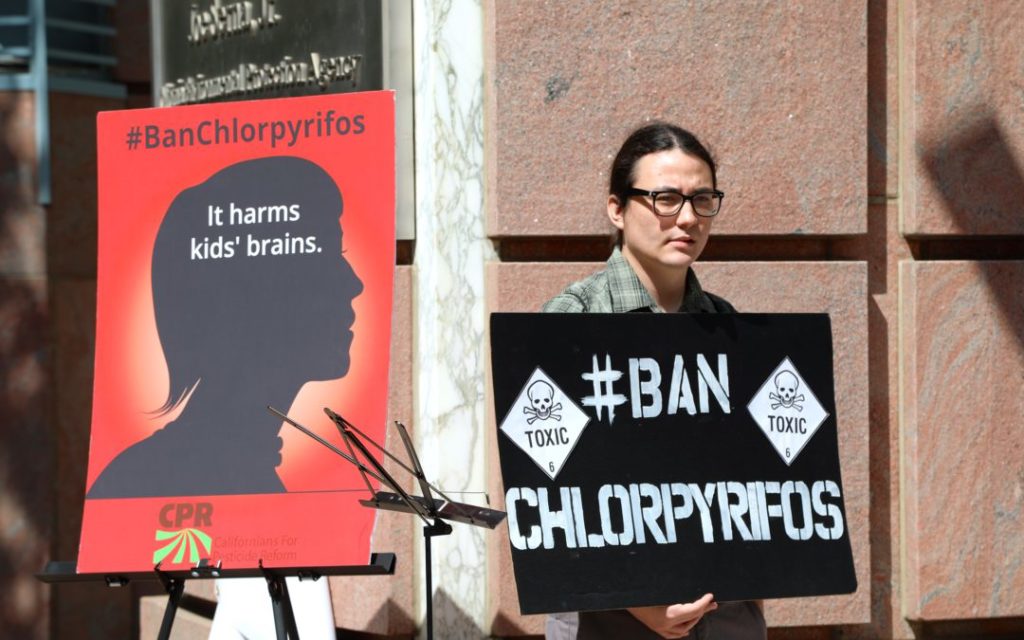Nerve agent chlorpyrifos is a Toxic Air Contaminant that threatens agricultural communities and harms children’s developing brains, state scientists agree
SACRAMENTO — California took a step closer Monday to curbing the use of a pesticide linked to permanent brain harm, including ADHD, autism and IQ loss. Sixteen months after disgraced former EPA Administrator Scott Pruitt defied his own scientists and refused to ban the neurotoxic organophosphate chlorpyrifos, the California Department of Pesticide Regulation (DPR) has concluded their own study by largely agreeing with the EPA scientists: current uses of chlorpyrifos put children at risk from unsafe levels of exposure from residues on food, contaminated water, and pesticide drift up to half a mile. Now, children’s health advocates are pushing the department to follow the science with sound policy, and become the second state in the nation to ban it. Hawaii’s state legislature passed a statewide ban in May.
DPR’s scientific conclusions were announced at a hearing convened Monday by the state’s Scientific Review Panel (SRP), a body of independent scientists overseeing DPR’s risk assessment of chlorpyrifos. Review of the chemical had been on hold for many years pending the proposed federal ban. The SRP formally accepted the risk assessment Monday, and unanimously agreed to designate chlorpyrifos a Toxic Air Contaminant, joining a list of 46 other chemicals including a number of fumigant pesticides. DPR now has ten working days to initiate the regulatory process formalizing the Toxic Air Contaminant designation.
“We’re glad that the state has finally accepted the overwhelming consensus of federal and independent scientists who’ve studied chlorpyrifos for years and determined that it harms kids’ brains severely and irreversibly,” said Mark Weller, co-director of the statewide coalition Californians for Pesticide Reform.
It’s what comes next that will determine for how long California’s communities will continue to be put at risk. DPR has the authority to halt exposures immediately by suspending use in California while formal assessment of control options are considered. However, DPR may also follow the timeline under the Toxic Air Contaminant regulations that allow for two years to decide how to mitigate the risk to children’s brain health. And meanwhile, almost a million pounds continues to be used on California’s food crops each year, exposing thousands of children and pregnant women to a chemical that permanently damages the developing brain.
In Ventura County, more than 100 pounds of chlorpyrifos were applied within one mile of at least five schools in 2016 (latest data), including Briggs School (255 pounds), Carden Kids Academy Preschool (287), CSU Channel Islands (287), Little Scholars Montessori (485), and Sheridan Way Elementary (190), according to CalPIP data. UC Davis researchers link increased chances for having children with Autism Spectrum Disorder at 14% for every 100 pounds of chlorpyrifos applications within one mile (1.5 kilometers) of the mother when she was pregnant. That means a 28% increase for 200 pounds; 42% for 300 pounds, etc.
“With everything we now know, it’s unconscionable that this toxic chemical is still being used on food crops in California,” said Miriam Rotkin-Ellman, senior scientist at the Natural Resources Defense Council (NRDC). “The state must immediately suspend all use of chlorpyrifos to protect kids, farmworkers and agricultural communities.”
Californians for Pesticide Reform is a diverse, statewide coalition of over 190 member groups working to strengthen pesticide policies in California to protect public health and the environment. Member groups include public and children’s health advocates, clean air and water groups, health practitioners, environmental justice groups, labor, education, farmers and sustainable agriculture advocates from across the state.

